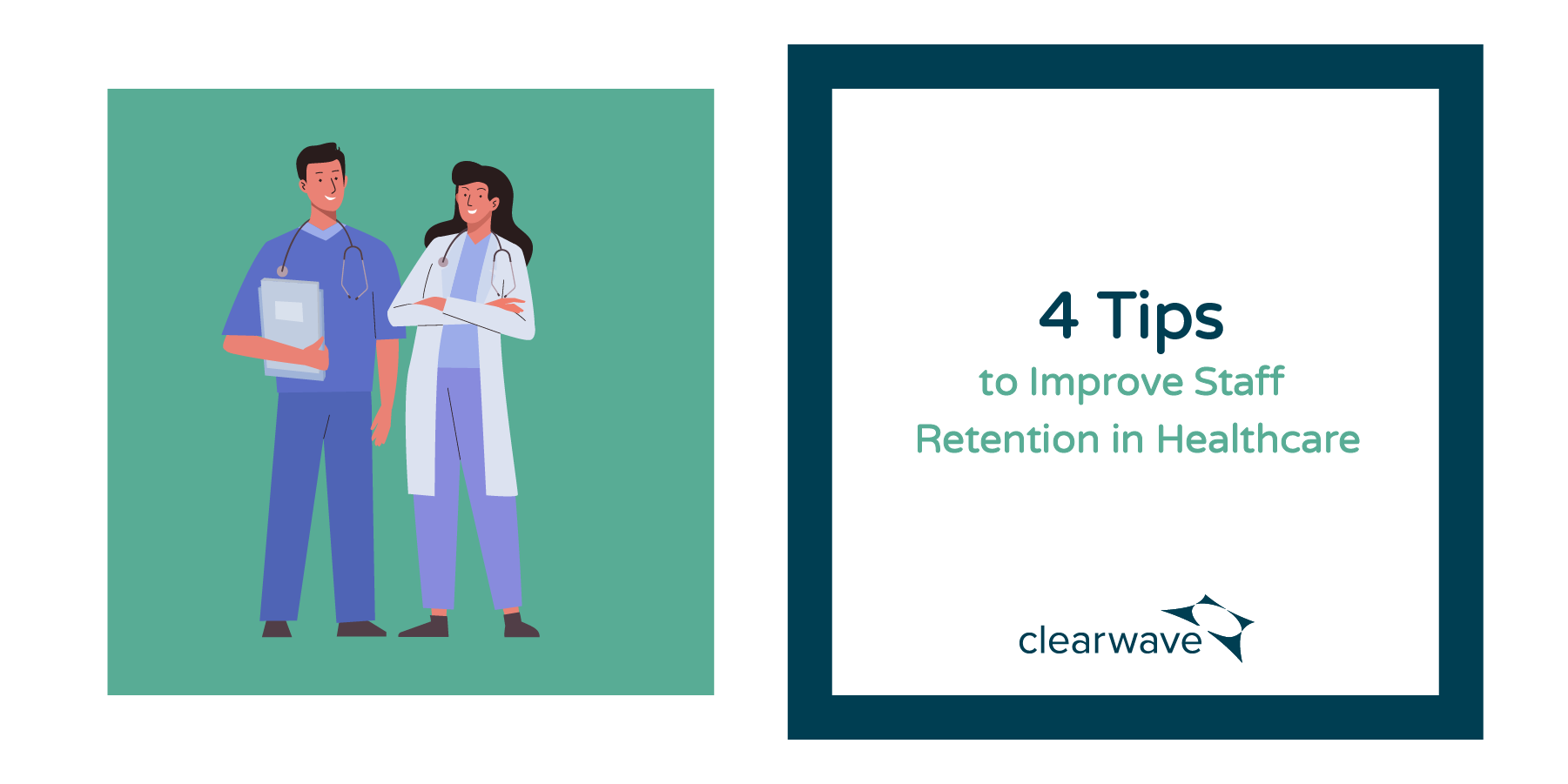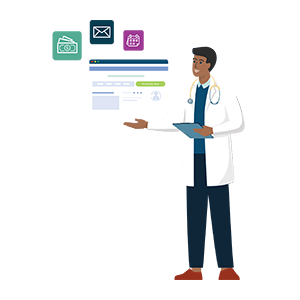4 Tips to Improve Staff Retention in Healthcare

By Chloe From Clearwave | August 11, 2025
Turnover rates continue to increase across many healthcare organizations, leaving an impact that extends far beyond vacant positions. When skilled professionals leave, the remaining staff face increased workloads, higher stress levels and burnout. Staff retention must extend beyond keeping employees happy and focus on maintaining quality patient care, preserving institutional knowledge and protecting your bottom line.
The good news is that many retention challenges stem from operational inefficiencies that can be addressed with the right technology and processes, especially at the administrative level. By reducing front desk and billing burdens and eliminating frustrating manual tasks, healthcare organizations can create environments where staff feel valued and empowered to focus on what matters most: patient care.
Here are four proven strategies to improve staff retention in healthcare by streamlining operations and reducing workplace stress.
1. Implement Online Scheduling to Reduce Phone Management
Front desk staff spend countless hours fielding calls, checking availability, and managing schedule changes, often while trying to assist patients who are physically present in the office. This constant interruption creates a stressful work environment where staff members feel like they’re always behind. When employees are overwhelmed by phone volume, they’re more likely to experience burnout and consider leaving for positions with more manageable workloads.
As a result, one of the most significant sources of staff frustration in healthcare settings is the constant barrage of phone calls. While patients will always be calling in, there are ways to reduce and migrate phone traffic to other sources, like an online scheduling tool!
Online scheduling systems directly address this challenge by allowing patients to book, reschedule, and cancel appointments independently, 24/7.
The Impact on Staff Satisfaction
When patients can self-schedule online, front desk staff experience immediate relief from phone pressure. Dustin Bostwick from Marietta Eye Clinic explains,
“We wanted to take some of the pressure off our call center agents. With so many locations and high-frequency call times, like Mondays or end-of-year periods, the volume is overwhelming.”
The results speak for themselves. Marietta Eye Clinic saved over 1,500 FTE hours in just one year by implementing Clearwave’s online scheduling system, seeing over 18,000 appointments booked online. Bostwick noted the immediate daily impact:
“For instance, Mondays used to be overwhelming. Now, in just one day alone, we’ve seen upwards of 87 appointments scheduled directly by patients online. If you estimate each booking at five minutes per call, then we’ve already saved over 7 hours.”
This example demonstrates how online scheduling creates a measurably better work environment for healthcare staff by reducing call volume stress and allowing them to focus on more complex patient needs. By shifting a majority of phone traffic online, administrators can focus on higher-value activities, such as patient questions or insurance verification.
This shift from reactive to proactive work significantly improves job satisfaction and reduces stress levels. Staff members report feeling more accomplished when they can complete meaningful tasks without constant interruption.
Online scheduling also eliminates the frustration of playing phone tag with patients who are difficult to reach during business hours. Instead of multiple callback attempts, patients can view availability and book at their convenience.
Patient self-scheduling software typically incorporates automated confirmation and reminder features, further reducing the administrative burden on staff. When patients receive automatic reminders via text or email, it decreases no-show rates and minimizes last-minute scrambling to fill empty slots.
2. Streamline Registration with Patient-Led Tools
Patient registration is traditionally a time-consuming process that requires significant staff involvement. From collecting insurance information to updating demographics and obtaining signatures, the manual registration process can create bottlenecks that frustrate both patients and staff. When front desk employees are constantly occupied with lengthy check-in procedures, they can’t provide the attentive service that both patients and staff prefer.
Staff retention in healthcare improves dramatically when employees feel they can work efficiently and provide excellent service.
Even when practices attempt to offer self-service check-in, the staff impact can fall short. Rather than simply digitizing tasks while keeping staff heavily involved. However, patient-led solutions are built to empower patients to take control of their healthcare experiences and reduce staff involvement in tedious scheduling and registration tasks — creating a better experience all around
Reducing Workload and Improving Accuracy
When patients complete registration independently, staff members can focus on other pre-appointment tasks or patients’ questions rather than monotonous data entry. This shift not only makes the work more engaging but also reduces the risk of data entry errors that can cause additional stress and rework.
Self-service registration tools also eliminate the awkward dynamic of staff members asking patients about sensitive information in public waiting areas. Instead, patients can privately complete forms, creating a more comfortable experience for everyone involved.
As Kassandra Duby, Site Director at East Jordan Family Health Center, explains: “Our staff appreciates the kiosks. They no longer have to navigate difficult conversations about documentation or spend time scanning paperwork. Now, they can focus on providing a welcoming experience.”
The technology also helps staff manage their time more effectively. Rather than dedicating large blocks of time to individual patient registration, staff can quickly review completed forms and address any issues or questions that arise. This efficiency improvement helps staff feel more productive and less overwhelmed by their daily responsibilities.
3. Optimize Revenue Cycle with Digital Collections
Financial conversations are one of the most challenging aspects of healthcare administration. Staff members often feel uncomfortable discussing payment obligations with patients, especially when dealing with past-due accounts or unexpected bills. These conversations can become tense and emotionally draining, contributing to job stress and turnover.
Digital collections systems remove much of this burden by automating payment communications and providing patients with convenient self-service collection options. When patients receive automated payment reminders via text or email, they can address their obligations privately without putting staff in the uncomfortable position of making collection calls.
Creating a More Positive Work Environment
Staff retention in healthcare improves when employees can focus on care coordination rather than financial administration or tedious collections tasks. Digital collections tools handle routine payment communications, allowing staff to concentrate on helping patients understand their benefits and navigate insurance complexities.
These systems also reduce the emotional toll of collections work. Instead of making difficult phone calls about overdue accounts, digital tools can prompt for past-due payments and estimations right at check-in.
Concord Orthopaedics demonstrates this impact perfectly. By automating their estimation and collection processes, they reduced their financial administration staff from five full-time employees to just one, saving $179,000 annually while achieving a 22% increase in self-pay payments. As CEO, Jennifer White explains:
“Our goal was to allow the technology to handle the finances of healthcare, so our staff can focus on patient care.”
4. Leverage Automated Communications to Reduce Administrative Burden
Manual communication tasks consume a significant amount of staff time and energy. From appointment reminders to patient education and payment notifications to post-visit follow-ups, healthcare teams spend countless hours on routine outreach that could be automated. This repetitive work not only reduces efficiency but also prevents staff from engaging in more meaningful patient interactions.
Automated patient communication systems handle routine messaging, ensuring patients receive timely and relevant information. Staff members can focus on complex patient needs and exceptions rather than spending their days making reminder calls and sending routine messages.
Improving Work-Life Balance
When staff members aren’t constantly occupied with routine communication tasks, they can complete their work more efficiently and avoid overtime. This improvement in work-life balance is crucial for staff retention in healthcare, where burnout rates are already high.
Truly effective patient communication software does more than just send reminders; it transforms administrative workflows, enhances patient engagement and supports provider satisfaction. To keep staff workloads low, it’s key to find one solution to automate patient communications before, after and between visits.
Automated patient communication tools should provide consistency in patient communications, reducing the stress staff feel when they’re unable to reach every patient personally. Knowing that automated reminders are being sent allows staff to prioritize other responsibilities without worrying about missed communications.
The technology also enables staff to be more responsive to urgent patient needs. When routine communications are automated, staff can quickly address time-sensitive issues and provide personalized attention where it’s most needed. See how Clearwave and Vital Interaction work together to streamline communications across the patient lifecycle, while dropping staff workloads significantly.
What Role Does Technology Play in Staff Retention?
Technology isn’t just about efficiency. It’s about creating work environments where healthcare professionals can thrive. When staff members have tools that eliminate frustrating manual tasks, they’re more likely to find satisfaction in their roles and remain with their organizations in the long term.
The key is implementing solutions that truly reduce workloads rather than simply shifting them. Effective healthcare technology should automate routine tasks while providing staff with enhanced tools for complex patient interactions. This balance allows employees to focus on the aspects of their jobs they find most rewarding.
Transform Your Staff Retention Strategy with Clearwave
While competitive salaries and benefits are important, improving staff retention in healthcare truly demands operational excellence that allows employees to focus on meaningful work. By implementing online scheduling, patient-led registration, digital collections and automated communications, healthcare organizations can create environments where staff feel valued and empowered.
Ready to transform your staff retention strategy? Discover how Clearwave’s patient-led self-service platform can reduce administrative burden, improve staff satisfaction, and help you build a more stable, engaged workforce that’s equipped to provide exceptional patient care.




